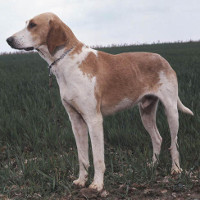 |
Great anglo-french white and orange hound |
|
FCI standard Nº 324 |
||
Origin |
France | |
Translation |
Mrs. Peggy Davis, brought up to date by Dr. J.-M. Paschoud | |
Group |
Group 6 Scenthounds and related breeds | |
Section |
Section 1.1. Large-sized Hounds | |
Working |
With working trial | |
Acceptance on a definitive basis by the FCI |
Thursday 27 January 1983 | |
Publication of the official valid standard |
Tuesday 01 August 2023 | |
Last update |
Friday 06 October 2023 | |
En français, cette race se dit |
 |
Grand anglo-français blanc et orange |
Diese Norm ist in deutscher Sprache sichtbar |
 |
Grosser Anglo-französischer Weiss-oranger Laufhund |
En español, esta raza se dice |
 |
Gran sabueso anglo-francés blanco y naranja |
In het Nederlands, wordt dit ras gezegd |
 |
Grote witte en oranje Anglo-Franse |
Usage |
| Scenthound. |
General appearance |
| Quite a strong dog, powerful, showing more English blood in his head than his tricolour colleague. |
Head |
||
Cranial region |
||
Head |
Quite short and broad. | |
Skull |
Rather broad and flat without occipital protuberance; superciliary arches not prominent. | |
Stop |
Well marked. | |
Facial region |
||
Nose |
Black or orangy brown. | |
Muzzle |
Bridge of nose rather short. | |
Lips |
Extending over the lower jaw and giving the muzzle some squareness. | |
Eyes |
Big, brown and dark. | |
Ears |
Set on quite broadly at eye level line or slightly above, quite thick, slightly turned in and rather short. | |
Neck |
| Straight; slight dewlap. |
Body |
||
Back |
Broad and muscular. | |
Loin |
Broad, rather short. | |
Croup |
Rather round. | |
Chest |
Quite deep and let down. Ribs long, slightly rounded. | |
Side |
Well filled out. | |
Tail |
| Quite long, sometimes towards the tip with few longer and coarser, slightly offstanding hairs (like ears of grain) around the tail. |
Limbs |
Forequarters |
||
Generality |
Strong, broad and vertical. | |
Shoulders |
Close to the chest but well muscled. | |
Hindquarters |
||
Upper thigh |
Muscular and fleshy. | |
Hock |
Slightly bent and close to the ground. | |
Feet |
| Rather round. |
Gait and movement |
| Easy. |
Skin |
| White with orange or yellow patches. |
Coat |
||
Hair |
Short and not too thick. | |
Colour |
White-lemon or white-orange on condition that the orange is not too dark tending to red. | |
Size and weight |
||
Height at withers |
60 cm to 70 cm. | |
Faults |
| • Any departure from the foregoing points should be considered a fault and the seriousness with which the fault should be regarded should be in exact proportion to its degree and its effect upon the health and welfare of the dog and its ability to perform its traditional work. • Faults listed should be in degree of seriousness. |
General faults |
 Faults of conformation. Faults of conformation. Butterfly nose. Butterfly nose. Muzzle too thin. Muzzle too thin. Over-or undershot mouth. Over-or undershot mouth. Light eyes. Light eyes. Excessive dewlap. Excessive dewlap. Curved tail or deviated to the side. Curved tail or deviated to the side. Colours of coat other than those previously mentioned (black or red hair). Colours of coat other than those previously mentioned (black or red hair). |
Disqualifying faults |
 Aggressive or overly shy dogs. Aggressive or overly shy dogs. |
NB : |
| • Any dog clearly showing physical or behavioural abnormalities shall be disqualified. • The above mentioned faults when occurring to a highly marked degree or frequently are disqualifying. • Male animals should have two apparently normal testicles fully descended into the scrotum. • Only functionally and clinically healthy dogs, with breed typical conformation should be used for breeding. |
Bibliography |
| http://www.fci.be/ |






















 English (United Kingdom)
English (United Kingdom)